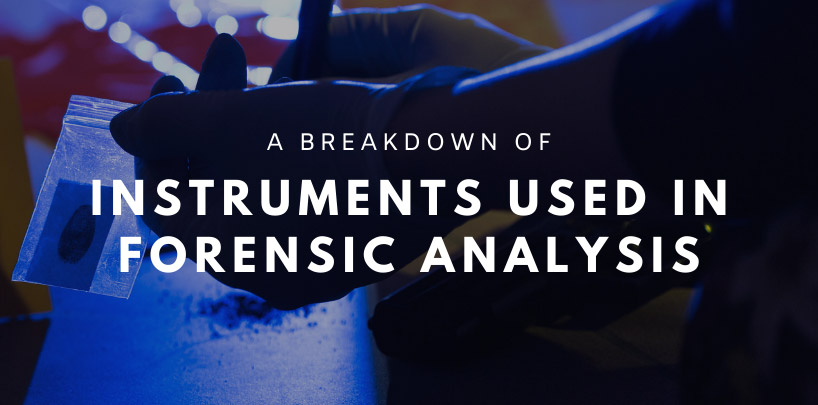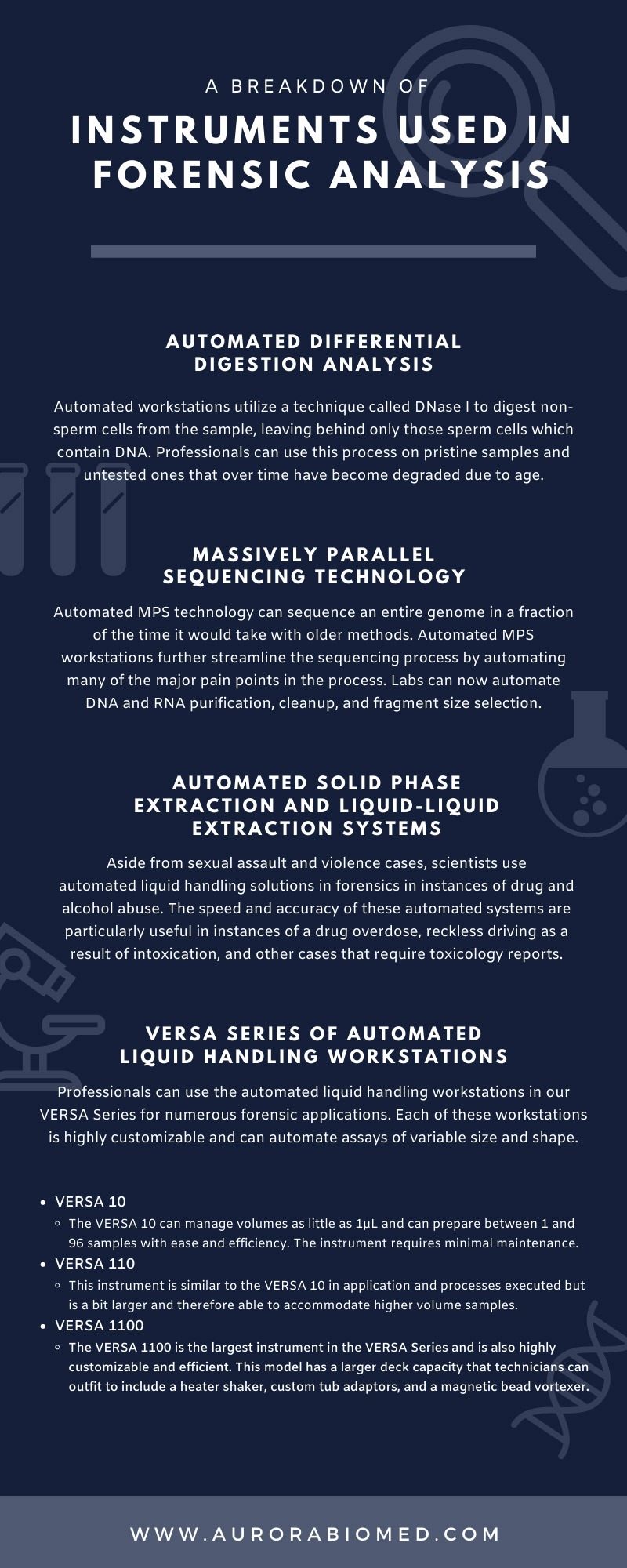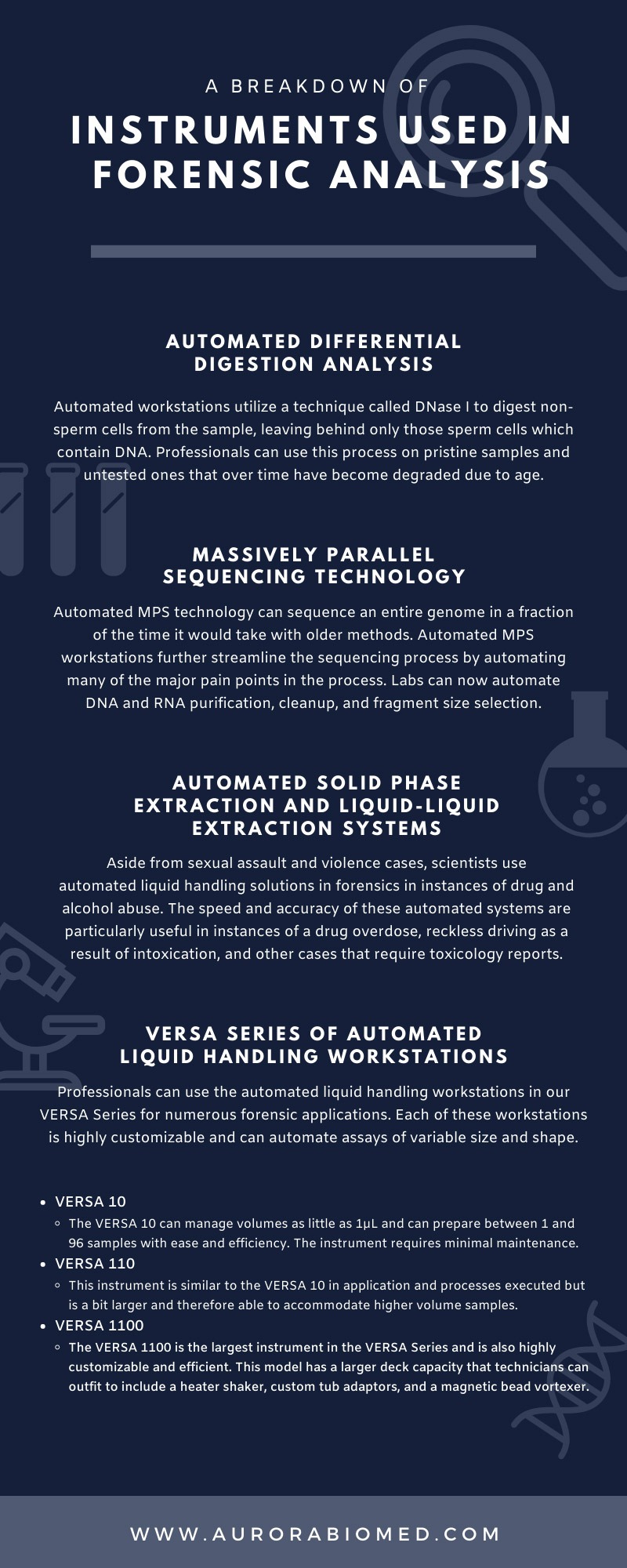
Throughout history, the field of forensics has seen many important changes and technological advancements. Far from the days of hand-drawn wanted sketches and unreliable finger-printing, modern forensic labs now utilize much more sophisticated equipment. This article provides a brief breakdown of instruments used in forensic analysis. Learn about the way these instruments help streamline many of the processes used in forensic laboratories around the world.
Automated Differential Digestion Analysis
The backlog of untested sexual assault kits is a growing concern in crime labs across the United States. This backlog is due to the high volume and demand for sexual assault kit testing and the lengthy analysis process required to test these kits. The process of differential digestion can be quite a lengthy process. This is because scientists must identify sperm cells and separate them from other cell types (often epithelial cells). The development of automated workstations streamlines this process, enabling crime labs to process evidence at a much faster rate. These workstations utilize a technique called DNase I to digest non-sperm cells from the sample, leaving behind only those sperm cells which contain DNA. Professionals can use this process on pristine samples and untested ones that over time have become degraded due to age. Automating the differential digestion process helps minimize major pain points in the process, including lengthy wash steps, time-consuming centrifugation steps, and low sample processing abilities. This enables lab technicians to process a higher number of sexual assault kits at a faster rate.
Massively Parallel Sequencing Technology
DNA plays an extremely important role in forensics and is instrumental in the identification of guilty parties. Before the development of massively parallel sequencing technology (MPS), sometimes called next-generation sequencing (NGS), certain techniques were difficult to complete. The processes of separating DNA samples, identifying specific sequences, and extrapolating that data to make more accurate ancestry and phenotype predictions have become much more common. Previous methods and technologies used in DNA sequencing required many lab technicians to work long hours. Now, automated MPS technology can sequence an entire genome in a fraction of the time it would take with older methods. Automated MPS workstations further streamline the sequencing process by automating many of the major pain points in the process. Labs can now automate DNA and RNA purification, cleanup, and fragment size selection. Library construction, normalization and pooling, and sequencing reaction setup are a few other steps that MPS technology can automate as well. Automizing these steps significantly reduces the risk of cross-contamination and increases reliability and accuracy in providing reproducible results.
Automated Solid Phase Extraction and Liquid-Liquid Extraction Systems
Aside from sexual assault and violence cases, scientists use automated liquid handling solutions in forensics in instances of drug and alcohol abuse. Various forensic laboratories can use automated solid-phase extraction (SPE) and liquid-liquid extraction (LLE) systems, such as those in the VERSA series. These systems can help identify the amount and type of substance in a blood or urine sample. The speed and accuracy of these automated systems are particularly useful in instances of a drug overdose, reckless driving as a result of intoxication, and other cases that require toxicology reports. Preparing the samples using automated SPE systems fully automates the otherwise lengthy process, enabling lab technicians to better allocate their time and skills elsewhere. This creates a more efficient practice overall. By utilizing automated workstations, the propensity for human error decreases significantly. Lab technicians can rest assured that their samples are properly prepared, ordered, and free of contamination. These instruments still utilize standard methods of liquid-liquid and solid-phase extraction but can do so at an expedited rate. As such, labs can better manage the ever-growing amount of casework.
VERSA Series of Automated Liquid Handling Workstations
Professionals can use the automated liquid handling workstations in our VERSA Series for numerous forensic applications. Each of these workstations is highly customizable and can automate assays of variable size and shape. While some instruments better suit certain applications and laboratory settings due to their size and customization, this doesn’t limit the collection. Each instrument in the VERSA Series is extremely adaptable and can provide efficient and reliable results.
VERSA 10
The most compact instrument in the VERSA Series, the VERSA 10 stands at just over 20 inches tall and weighs only 68 pounds. Though it may be small in stature, this instrument is extremely flexible and reliable. Because of its compact nature, the VERSA 10 is also quite cost-effective, making it a popular model for smaller laboratories. The VERSA 10 can manage volumes as little as 1µL and can prepare between 1 and 96 samples with ease and efficiency. The instrument requires minimal maintenance and, due to the use of disposable tips, there is also a low risk of contaminating samples. Professionals can use the VERSA 10 to assist in a variety of processes that are invaluable to the study of forensics. This includes NGS library normalization and pooling and sequencing reaction set-up.
VERSA 110
The VERSA 110 is also highly versatile and customizable. This instrument is similar to the VERSA 10 in application and processes executed but is a bit larger and therefore able to accommodate higher volume samples. The VERSA 110 can successfully manage volumes between 30nL and 1000µL. It also has an eight-positioned modular deck that enables lab technicians to analyze a larger number of samples in a shorter time. Unlike other systems in the VERSA Series, the VERSA 110 utilizes a dual-syringe pump. This effectively eliminates the need for multi-pipetting and therefore increases efficiency and speed.
VERSA 1100
The VERSA 1100 is the largest instrument in the VERSA Series and is also highly customizable and efficient. This model has a larger deck capacity that technicians can outfit to include a heater shaker, custom tub adaptors, and a magnetic bead vortexer. Use the VERSA 1100 for several applications within the field of forensics. For example, NGS library preparation in cases of sexual assault and solid-phase extraction in cases of drug and alcohol abuse. Labs can also customize this system to include a HEPA/UV/LED enclosure, further reducing the risk of contamination.




